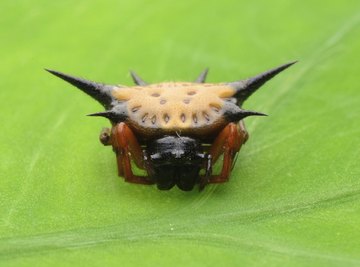
Texas is a huge climate transition zone, ranging from deserts in the west to swamplands in the east. Not surprisingly, the state’s varied habitats host one of the most varied populations of spiders in the southwestern United States—more than a thousand species, according to Texas A&M University’s Department of Entomology.
The most attractive area for spiders seems to be South Texas, where nearly 900 species make their home, including the venomous black widow and brown recluse spiders.
Black Widow
The poisonous black widow spider lives indoors and outdoors throughout Texas. Its venom is a neurotoxin that can cause severe systemic reactions in humans, (including death, on rare occasions). The animal earned its name from its appearance, and from the mating behavior of the female spider. Female black widows are jet black in color, with a globular abdomen bearing a reddish or yellowish "hourglass" marking on the underside. After mating with the smaller, brown males, black widows devour them.
Brown Recluse
These spiders are golden brown in color, with a dark brown fiddle-shaped pattern around the head. They are nocturnal hunters that like to seclude themselves in dark, sheltered or undisturbed areas. They commonly move into basements and garages, and hide between boards, boxes, old towels, firewood or clothes.
Although its venom is less toxic than the black widow’s, a brown recluse bite can cause fever, chills and nausea, as well as necrosis of the bite area. Organ damage or death may follow in rare cases.
Tarantula
There are 14 species of these heavy-looking, furry spiders in Texas, many of which occur in South Texas. They range in length from 1.5 to 3 inches, and are typically dark brown to brownish black in color, with thick legs and an abdomen covered with fur.
They’re commonly found in grasslands and semi-open areas, living in burrows or natural cavities under logs and stones, and feeding on insects and caterpillars. Each summer, large numbers of male tarantulas wander out into the open in search of mates.
Tarantulas have fangs to inject their poison into their prey, but they’re not poisonous to humans.
Yellow Garden Spider
This is one of the many species nicknamed “orbweavers,” because they produce ornate, circular webs in open fields, fences and gardens. The yellow garden spider has a particularly striking appearance due to its long, striped legs, and the yellow, black, orange or silver markings on its abdomen.
Spiny-backed Orbweaver
This orbweaver looks more like a crab than a spider. Its large, flat abdomen recalls the general shape of the crustacean; it has a few spikes at the edges and white, yellow, orange, black or red markings. Spiny-backed orbweavers generally live in in wooded areas.
References
About the Author
Rhonda McDowell launched her freelance career in 2008 by ghostwriting an e-book on health and gardening. Now, she writes primarily for eHow and enjoys delving into financial topics such as bankruptcy and foreclosure.
Photo Credits
defun/iStock/Getty Images
